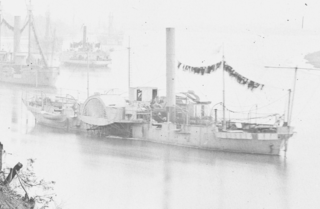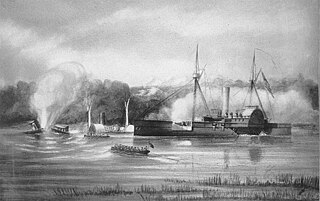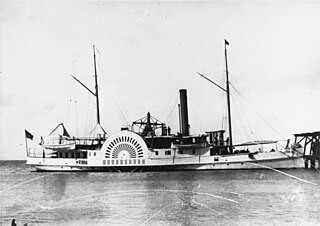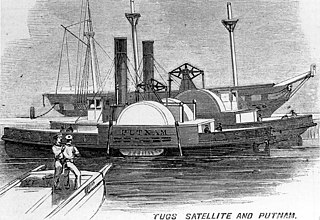
CSS Albemarle was a steam-powered casemate ironclad ram of the Confederate Navy, named for an estuary in North Carolina which was named for General George Monck, the first Duke of Albemarle and one of the original Carolina Lords Proprietor.

The first USS Miami was a side-wheel steamer, double-ender gunboat in the United States Navy during the American Civil War.
CSSCotton Plant, sometimes referred to as Cotton Planter, was built at Philadelphia, Pennsylvania in 1860 and reportedly carried troops in the Pamlico River as early as September 1861. She sailed with CSS Albemarle when that ironclad ram attacked Union forces at Plymouth, North Carolina, sank USS Southfield and drove off USS Miami, USS Ceres and USS Whitehead on April 18–19, 1864. On May 5, 1864 she steamed as convoy to Albemarle from the Roanoke River en route to the Alligator River. The convoy was engaged by ships of the North Atlantic Blockading Squadron in the Battle of Albemarle Sound, but both the ram and Cotton Plant with several launches in tow escaped into the Roanoke River.

USS Southfield was a double-ended, sidewheel steam gunboat of the Union Navy during the American Civil War. She was sunk in action against the Confederate ironclad ram CSS Albemarle during the Battle of Plymouth (1864).

USS Ceres was a small 150-long-ton (152 t) steamboat acquired by the Union Navy during the beginning of the American Civil War. She was outfitted as a gunboat and used in the Union blockade of the waterways of the Confederate States of America.

CSS Raleigh was originally a small, iron-hulled, propeller-driven towing steamer operating on the Albemarle and Chesapeake Canal. She was taken over by the State of North Carolina in May 1861, and transferred to the Confederate States the following July. Her commanding officer during 1861–1862 was Lieutenant Joseph W. Alexander. Her entire service was in coastal waters of North Carolina and Virginia and in the James River as part of the James River Squadron.

USS Stars and Stripes was a 407-ton steamer acquired by the U.S. Navy and put to use by the Union during the American Civil War.

USS Wyalusing was a double-ended, side-wheel gunboat that served in the United States Navy during the American Civil War. She was named for the borough of Wyalusing in Bradford County, Pennsylvania.

USS Commodore Perry was a 512-long-ton (520-tonne) steamer acquired by the Union Navy in 1861, the first year of the American Civil War. She was named after Commodore Oliver Hazard Perry (1785–1819), a naval officer who had commanded American forces on Lake Erie in the War of 1812. In January–February 1862, Commodore Perry was part of the North Atlantic Blockading Squadron, taking part in the attack, in cooperation with the Union Army, which resulted in the surrender of Roanoke Island by the Confederate States of America. She participated in several other campaigns through 1862, including the capture of Elizabeth City, North Carolina, and army–navy expeditions against Franklin, Virginia, and Hertford, North Carolina. From 1863 until the end of the war, she was engaged in patrols, both inland and in Virginia coastal waters.
Alexander S. Crawford was a sailor in the United States Navy who served in the American Civil War. He received the Medal of Honor for his actions during the war.

The Battle of Elizabeth City of the American Civil War was fought in the immediate aftermath of the Battle of Roanoke Island. It took place on 10 February 1862, on the Pasquotank River near Elizabeth City, North Carolina. The participants were vessels of the U.S. Navy's North Atlantic Blockading Squadron, opposed by vessels of the Confederate Navy's Mosquito Fleet; the latter were supported by a shore-based battery of four guns at Cobb's Point, near the southeastern border of the town. The battle was a part of the campaign in North Carolina that was led by Major General Ambrose E. Burnside and known as the Burnside Expedition. The result was a Union victory, with Elizabeth City and its nearby waters in their possession, and the Confederate fleet captured, sunk, or dispersed.

The Battle of Albemarle Sound was an inconclusive naval battle fought in May 1864 along the coast of North Carolina during the American Civil War. Three Confederate warships, including an ironclad, engaged eight Union gunboats. The action ended indecisively due to the sunset.

USS Delaware was a steamer acquired by the Union Navy for use during the American Civil War. She had a very active naval career as a gunboat for over three years, and after the war served as a revenue cutter for over 37 years. The steamer was sold to the private sector in 1903, and disappeared from shipping registers in 1919.

USS Valley City was a 190-ton steamer acquired by the Union Navy for service in the American Civil War.

USS Young America was a Confederate steamer captured by the Union Navy’s blockade vessels, and subsequently placed in-service in the Union Navy during the American Civil War.

USS General Putnam – also known as the USS William G. Putnam – was acquired by the Union Navy during the first year of the American Civil War and outfitted as a gunboat and assigned to the Union blockade of the Confederate States of America. She also served as a tugboat and as a ship's tender when so required.

USS Underwriter was a 341-ton sidewheel steamer that was purchased for military use by the Union Navy during the American Civil War.

USS Hetzel was a steamer acquired by the Union Navy during the American Civil War. She was used by the Navy to patrol navigable waterways of the Confederacy to prevent the South from trading with other countries.
USS Shamrock was a large seaworthy steamer with powerful guns, acquired by the Union Navy during the American Civil War. She was used by the Union Navy as a gunboat in support of the Union Navy blockade of Confederate waterways.
USS Henry Brinker was a small steamship acquired by the Union Navy during the American Civil War. She was placed into service as a gunboat and assigned to the blockade of ports of the Confederate States of America.
















